Equipment Insight: Excavators
Advances in technology make gains in productivity, efficiency and safety.
Hydraulic excavators are versatile additions to any rental fleet and new models are offering more advanced technology that improves their productivity, safety and ROI.
 |
|
|
In conjunction with more efficient hydraulic systems, Cat excavators offer operating modes such as Smart Mode to help lower operating costs while ensuring performance is matched to the job site. |
|
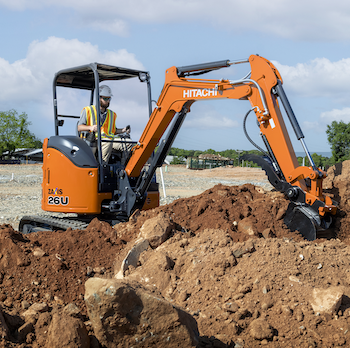 |
|
| Many Hitachi compact excavator models feature power/economy modes that are usually only available on larger excavator models. These modes allow the operator to match the engine speed to the job. | |
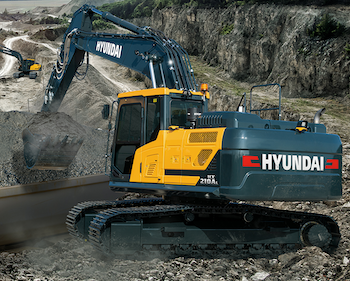 |
|
|
|
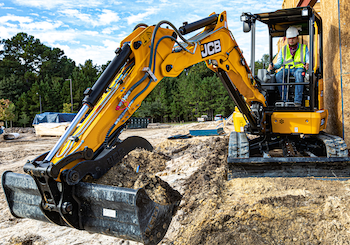 |
|
|
|
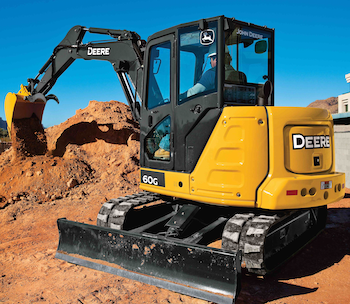 |
|
|
|
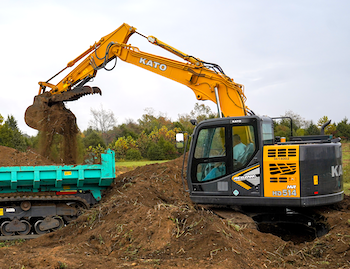 |
|
|
|
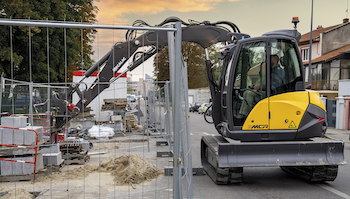 |
|
| Mecalac compact excavators have the ability to legally operate as a crane with a published load chart, have a significantly reduced operating radius and have travel speeds double that of any other small excavator. | |
| NEw Holland TBD | |
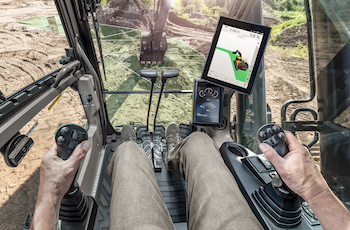 |
|
| Assistive software, like Volvo’s Dig Assist, makes work faster and easier by allowing the operator to automate some of the most common tasks such as leveling and sloping, creating layers of different materials or weighing the material moved. | |
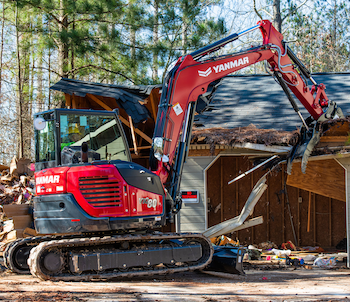 |
|
| Cabs are seeing improvements in ergonomics, such as switches and displays that are more viewable and controls that are easier to use. Enhanced attachment coupling options also improve efficiency on the job site, with hydraulic options allowing switching attachements without leaving the cab. | |
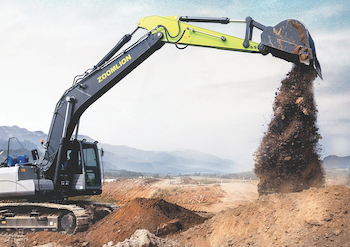 |
|
| On large drainage projects, 3D grade guidance/control can form complex shapes and designs. Plans are downloaded from off-site engineers using software programs such as Autodesk Civil 3D. Besides the four sensors used on 2D control/guidance, 3D uses a pair of GPS antennas plus an RTK radio positioning signal to achieve centimeter accuracy. |
But with more advanced technology, rental centers must consider models that may require more operator training to assure they get the top level of productivity the units can offer.
Pro Contractor Rentals asked hydraulic excavator experts on the trends they see customers are wanting from these units and how rental centers can achieve greater ROI on new units.
|
Senior Marketing Professional |
Technology reduces operating costs
Customers are always looking for ways to reduce operating costs, address labor challenges and maximize production. The advanced technologies on Cat excavators, such as grade control and payload system are two great examples that answer those customer needs. Standard Grade Control with Assist helps operators quickly get to and stay on grade. This lowers operating costs by requiring less time, less fuel, less rework, less import material while providing high quality finished product.
This also helps newer or less-experienced operators be more proficient and learn at a faster rate. This is important, especially in today’s market where finding and retaining quality operators is a major challenge for contractors.
The standard Cat Payload system helps operators prevent under- or over-loading trucks as well as providing production information. This helps customers maximize productivity and ensure the most cost-effective trucking of material.
Additionally, advances in smart electro-hydraulic systems help customers lower operating costs through increased efficiency and ultimately lower fuel consumption. In conjunction with more efficient hydraulic systems, there are also operating modes such as Smart Mode to help lower operating costs while ensuring performance matched to the job site.
Smart Mode can automatically adjust the power based on the operator and application demands. So, in light- to medium-duty applications, the machine behaves more like it’s in economy mode, and while in more demanding applications, the machine automatically provides maximum or high power to ensure the highest level of performance.
As rental center managers contemplate expanding or updating their excavator fleet, decisions should revolve around on how to maximize ROI while meeting customer needs. Standard grade and payload technologies should be considered. These technologies need to be a part of the rental center strategy and delivery process to help differentiate the offering to contractors and ensure they understand the value of what these technologies can do for them.
Other more traditional considerations are understanding and promoting fuel-saving features and technology such as Smart Mode or Engine Idle Shutdown.
It is also critical that the rental center decision makers are properly configuring the machines to meet the needs of its customer base and provide the most versatility. This includes specifying auxiliary hydraulics, quick-coupler circuits and a range of the most used attachments.
Rental centers should also consider providing differentiated rental rates that match the machine offering to the most common types of applications of customers in their market. For example, Cat Next Gen excavators include the GC range of machines. The GC models are focused on lower acquisition and operating costs yet provides a base level of performance that matches very well to common applications where maximum productivity is not always required.
Rental centers can do several things to focus on increasing demand and ROI. Utilizing the standard Grade and Payload technologies on Next Gen excavators provide customers with a differentiated product that can lower operating costs and increase job site efficiency. Many customers are already asking for these technologies and see the value of renting machines with these features.
It is also critical rental centers have a well-maintained, inspected, lower-hour fleet of machines. This ensures maximum uptime for customers. Also, having the right machine configuration and versatility of that configuration, along with the most popular work tool attachments, is critical to matching the rental fleet offering to the needs of the market.
 |
|
Product Specialist |
Fuel efficiency gains importance
Fuel efficiency is clearly a need for customers right now and the Doosan D-Eco Power system in new -7 Series excavators improves productivity and saves fuel. An electronically controlled pump, closed-center main control valve and system sensors electronically detect and control the precise amount of hydraulic power required to perform a task. The exact amount of hydraulic fluid required is metered instead of a fixed amount of fluid continuously being forced through the system. That means the hydraulic and engine power are matched in any digging condition to maximize fuel efficiency and improve productivity.
Improved feedback through the controls results in an outstanding level of operator comfort and much smoother machine operation.
Another technology that supports fuel efficiency in the new Doosan excavators is Speed Control, which enhances fuel efficiency by reducing engine speed in the low-load range to an appropriate level through variable engine speed control. It does this by detecting actual engine load and the operator’s activity for heavy-load operations. Speed Control works hand in hand with Smart Pump Torque Control, which reduces unnecessary engine load through optimized control of pump torque to match the engine torque.
When considering whether to add new models to the excavator fleet, cost of ownership is always the chief concern for any rental center. Upfront cost, the durability of the machine and how easy it is to maintain are crucial.
Beyond that, support from not just the dealer but also the OEM when necessary is very important. Some of the largest Doosan customers in North America work with Doosan because it meets with them as a manufacturer, understands their needs and comes up with customized solutions.
To increase demand or increase ROI with these units, the DoosanConnect telematics system is easy to use and can give rental centers more control over their rental fleets. The system allows rental centers to track the location of its excavators, set geofences for where they can be operated, see their maintenance needs and monitor how they are being operated. For example, the telematics system can track the number of hours the customer is putting on the excavator; it also allows fleet managers to see if someone is letting the excavator idle excessively, which can cause emissions trouble in any Tier 4 machine, and contact them to try to fix that behavior.
 |
|
National Rental Account Manager |
Fine-tuned performance for productivity
Fuel efficiency and productivity improvements are the results of power system enhancements. Many Hitachi compact excavator models feature power/economy modes that are usually only available on larger excavator models. These modes allow the operator to match the engine speed to the job. The power mode provides higher engine speed for most general digging work, while the economy mode reduces engine speed for lighter digging jobs. This results in lower noise and decreased fuel consumption.
Hitachi compact excavators also use the Triple H (HHH) hydraulic system, which enables combined operations by adjusting the optimal flow rate for all actuators. This gives the operator the freedom to provide simultaneous control inputs with no impact on machine performance. The compact excavators feature full hydraulic pilot control to maximize controllability for the boom, swing, travel, blade, bucket/thumb and other attachments.
The new standard-size Hitachi high-performance construction excavators use the TRIAS II three-pump hydraulic system, which offers the performance to excel at earthmoving, material handling, demolition, underground excavation and more. The pumps supply an optimal amount of pressurized oil to each actuator. These pumps are electrically controlled for precise oil flow for sensitive front attachment control and lower fuel consumption.
The TRIAS II technology minimizes hydraulic system losses by reducing the hydraulic oil returned to the tank. This helps lower fuel consumption in Eco mode with the same productivity. A high-power HP mode increases engine speed and hydraulic-pump output torque when extra speed and/or heavy-duty work is required.
Rental centers considering adding new models to their rental fleets should always consider simplicity of operation. The control pattern on Hitachi compact excavators can be quickly switched from backhoe- to excavator-style controls with a control-pattern selector located beneath the seat. This allows operators to use a familiar control pattern and be more productive during the workday.
Attachment versatility can result in higher utilization. The excavators should be ready to run multiple attachments with auxiliary plumbing installed on the stick. Hitachi compact excavators come with additional plumbing on the stick and selector valves to accommodate various types of attachments. An auxiliary function lever (AFL) is available with an analog switch, trigger switch and horn for running attachments, such as a breaker or an attachment with swing.
Ease of maintenance and durability are also key considerations, especially with compact excavators. Compact machines can be more challenging to maintain with components crowded into tight quarters. HCMA models group daily maintenance points behind easy-access covers and a large engine cover slides open vertically for access when the machine is in a confined area. All critical components can be accessed through easy-to-operate access panels. A hinged door provides wide-open access to the side-by-side oil cooler and radiator for easier cleanout.
Hitachi compact excavators are built to the same durability standards as larger Hitachi excavators. Oil-impregnated HN bushings are used on the boom, arm and bucket joints for increased durability. Heavy-duty X-frames provide a solid base that resists material and dirt buildup. A single-pin swing post increases the structural integrity of the digging components. Excavators that are plumbed to handle a wide range of attachments and include quick couplers for switching attachments can offer greater ROI.
This can increase the versatility and, therefore, the utilization rate. Being able to offer the right attachments to simplify a task makes the unit more attractive to the contractor.
The latest technology can help customers track performance and minimize downtime. Hitachi Global e-Service is available on many excavator models. It allows equipment owners to monitor their excavators remotely via Owner’s Site and ConSite, Hitachi’s full data toolkit with a suite of apps for managing machine performance and productivity.
ConSite tracks performance metrics including idle time, operating time and fuel efficiency along with providing location services in real time and it alerts owners and operators to upcoming maintenance needs. These predict-and-prevent tools help fleet managers maximize machine efficiency, minimize downtime and improve overall performance.
Senior Product Manager
Mike Fuller
Hyundai Equipment Americas
New-generation excavators add productivity, safety and efficiency
Rental centers traditionally have focused on the 8.5- to 14-metric ton excavator weight classes that they offer to customers. But as the demand increases for more powerful and versatile machines, there is a shift toward larger machines.
Hyundai has responded to that demand by creating a machine that provides the right combination of size, power, efficiency, versatility and affordability. All those factors come together in the recently introduced Hyundai HX210AL excavator, designed to appeal to rental houses and dealers with high volumes of rental business. The idea is to offer the rental center or dealer a machine that is easier to monitor and maintain and offer the customer a machine that is less complex, more intuitive and safer to operate.
The HX210AL is powered by a 170-horsepower Cummins B4.5 Stage 5/Tier 4 Final diesel engine. It is in the 22-metric ton class with a standard operating weight of 50,460 pounds. Standard bucket capacity is 1.3 cubic yards and the machine accepts a wide variety of attachments that also fit the larger Hyundai HX220AL excavator, with which it shares the same arm and coupler design.
The two models also share the same undercarriage, the same engine power rating and the same hydraulic system capacity and features. As a lighter machine with a slightly smaller upper structure, the HX210AL comes with a significantly lower price tag, which is a big consideration for rental houses, and helps them recoup their investment more quickly.
The Hyundai A Series machines offer a variety of new and enhanced standard features appealing to rental centers, dealers and end users. For example, the HX210AL excavator features Electric Positive Flow Control (EPFC) that improves fine control while reducing fuel consumption, ensuring the optimal balance of power, precision and economy.
Of interest to rental fleet operators is a new ability to edit menu functions available to the machine operator. This enables the machine owner to provide or restrict access for machine operators by using a password to lock or unlock the menu of control options.
Rental fleet operators also will appreciate Hyundai’s new auto safety lock feature that prevents unintentional operation. When the lock is activated, no hydraulic functions can be activated/operated.
Hyundai provides five years of free access to its global HiMate telematic monitoring system. With satellite and GSM connectivity, HiMate enables remote monitoring of productivity, fuel consumption, system warning and maintenance status, which can help reduce unplanned downtime and improve fleet utilization. HiMate also enables geo-fencing to keep the machine confined within prescribed geographic limits.
The HX210AL excavator also offers the optional Hyundai-exclusive All Around View Monitoring (AAVM) system, giving a 360-degree bird’s eye view around the machine, greatly improving jobsite safety. The system includes Hyundai’s Intelligent Moving Objects Detection (IMOD) technology. IMOD alerts the operator to the presence of anything within a 16.5-foot range of operation via an audible alarm and color changes displayed on the 8-inch in-cab monitor.
As another option, the HX210AL excavator incorporates Hyundai’s proprietary Two-Dimensional Machine Guidance (2D MG) system that displays the height of bucket teeth from the target depth and angle of the bucket in real-time. It’s ideal for trenching, grading and making a slope. With 2D MG, the operator can increase productivity by about 30 percent without a worker in the dig site for a safer work environment overall. The 2D MG provides a more cost-effective solution than 3D machine guidance systems.
The Cummins Performance Series engines in the Hyundai A Series lineup are the most environmentally friendly and fuel-efficient engines available today. With these engines, Hyundai’s A Series machines are approximately 7 to 11 percent more fuel efficient than previous comparable models.
Cummins’ Stage V-compliant engines offer several improvements over previous generation engine models, including improved power and torque, reduced complexity, enhanced reliability, reduced cooling system requirements and remote real-time diagnostics.
Product Manager – Excavators
Chris Lucas
JCB North America
Technological options becoming standard
JCB has improved the technology features on its excavator models to include standard features such as automatic health checks to eliminate the need for pre-start walk-arounds. Further, on JCB models, advanced tool select is standard, which simplifies changing attachments and makes attachment setup easy.
As rental centers consider adding excavators to their fleets, they need to consider their existing fleet of attachments in the selection process. JCB’s latest machines have universal attachment pick-up dimensions so customers with existing attachments can continue to use those with the new excavator models.
Rental houses should consider theft protection, uptime monitoring, maintenance concerns and the need to monitor potential abuse. These are available through JCB Livelink telematics, which comes standard with all JCB mini excavators; every JCB mini excavator comes with a free five-year subscription.
Rental centers can increase demand, and in turn, ROI by making sure the models are readily available. Demand is often measured by availability; who has machines available when the customer comes looking? One way to do this is by utilizing services such as data from Livelink telematics to schedule and preemptively control maintenance issues. Improved uptime means more time on the lot available for rent.
When comparing ROI across units, consider service intervals, serviceability and parts availability for that brand or model. Make sure your rental center offers the most demanded machine class for your market, and then consider ease of use for the operator. Each of these will improve equipment uptime, increase demand and reduce time needed to support the customer in the field.
For example, JCB excavator service intervals are more than 500-hour greasing intervals, 2,000-hour air filter life, 500-hour oil changes and 1,000-hour hydraulic oil changes. When it comes time for preventive maintenance, technicians will find the JCB excavators are very serviceable, with fully removable panels, large service doors, removable cab floors, tilting cabs and easy-access hydraulic valves. Further, JCB offers greater than 95 percent parts availability through its regional part distribution centers.
JCB excavators feature QR codes in every cab that will take customers directly to JCB’s landing page for Quick Start Guides, providing step-by-step instructions for most standard operating questions.
Solutions Marketing Manager
Justin Steger
John Deere
Consider lower-maintenance models
John Deere is committed to providing customers with solutions that meet their growing needs and continues to introduce new features to do just that.
With convenience always top of mind for operators, one important advance incorporated on all six John Deere G-Series compact excavator models is the standard mechanical wear-compensating couplers for buckets and attachments. G-Series units are compatible with the D-Series buckets, so operators can utilize equipment they likely already own.
In addition, John Deere uses oil-impregnated bushings in the front joints of the boom, arm and bucket. These bushings do not replace the need for grease; but rather provide extra protection should a joint not get greased properly.
There has been increasing demand among rental organizations for mini excavators that are versatile, reliable and compatible with new technology such as telematics. While auxiliary hydraulic lines have long been standard equipment on John Deere mini excavators for years, John Deere engineers have added a selector valve on the arm of all models 26G through 60G, enabling operators to plumb two attachments simultaneously. With a simple turn of the valve, the operator diverts hydraulic oil to the attachment he or she wants to use without swapping hoses.
When rental centers think about bringing new excavator models into their rental fleets, they must prioritize time, versatility and quality. Quality of the machines is very important when faced with companies with tight turnaround times. The machines should have the ability to run for longer periods of time, even when faced with harsh conditions. High-quality machines and proper routine maintenance will help limit maintenance downtime, ensuring the job site is always running on schedule.
Customers are also always looking for ways to increase efficiency and convenience on the job. Machines that offer versatility are an attractive option for any operator. For example, machines that are compatible with multiple attachments or machines that can easily fit in small spaces without sacrificing the power of larger-scale models, such as the John Deere 30G compact excavator, which is a good example.
The first thing rental centers can do to increase demand for a given machine is to make sure that it is configured to meet the needs of the market. Things such as model size, transportability, arm length and track type will dictate the demand for the excavator. Understanding the requirements of the local customer base – and then assembling a rental fleet based upon those needs – will return the highest yield. Standard rubber tracks and optional arm and counterweight configurations are just a few of the ways John Deere tries to make its mini excavators appealing to a broad set of users.
While Deere mini excavators are among the most reliable and durable machines in the Deere product portfolio, following regular maintenance will help rental centers get ahead of potential downtime issues and major repairs. Using the recommended engine oils, filters, grease, and coolants – and adhering to the service intervals – is key to getting the most out of your mini excavator.
Sales Representative
Doug Hacker
KATO CES
Comfort, versatility key
The excavator industry has set the bar extremely high and manufacturers are always striving to make better machines by creating the ultimate machine for users.
Kato is finding ways to meet these needs, starting with a larger ROPS/cabin. This allows the operator more space and higher visibility. The ergonomic design provides the ultimate in comfort and usability.
Versatility is key when it comes to equipment advances. Battery-powered excavators, zero tail-swing models and multiple hydraulic lines for uses ranging from couplers to attachments, such as a hydraulic hammer, brush cutter or rock crusher.
Key things to think about when rental centers are contemplating bringing a new excavator model into the fleet should be the overall machine performance – its weight, horsepower, breakout force, lifting capacity and digging depth. Customer demand is the key to selecting a new excavator for the fleet which can greatly affect ROI.
There are many ways to increase the demand or ROI with the new excavators. First would be to have a competitive machine that meets or beats industry standards. Identify the key points that help the overall demand and ROI; having units readily available is important, which means a larger fleet; and make sure it well maintained and service intervals are up to date to keep the machine operating at peak performance.
Rental centers can increase utilization with strong a marketing plan that includes social media, road signage and demo days.
Having a stellar sales team that has access to a fleet large enough to meet the market demand and having multiple buckets and attachments to meet the customer needs and demands can help improve utilization rates.
General Manager
Peter Bigwood
Mecalac North America
Look at multi-purpose machines
As job sites have more restricted access, contractors require more compact equipment and manufacturers continue to work on reducing the size of their machines, especially tail swing radius. However, this often has been at the expense of stability, lifting capacity and cab space.
Mecalac was the first manufacturer to recognize the need for new urban excavators that combine compactness with performance. Along with reducing the rear radius, Mecalac engineers have addressed boom design to ensure 360-degree compactness. A traditional excavator has a dipper mounted at the front of the machine, making it front-heavy and limited in its ability to operate in confined spaces. To eliminate that inefficiency, the patented Mecalac boom system can retract fully, making the machine compact both at the front and rear, while decreasing the height clearance above the machine.
Multi-purpose equipment can reduce operating costs. Traditionally, a multi-purpose machine excels at one function and offers mediocre performance on other functions. Mecalac has changed that by designing compact equipment that can serve as an excavator, a compact track loader and a material handler, and do it all equally well.
The 8MCR, Mecalac’s 8-ton skid excavator, for example, can travel at 6.2 mph, which is twice as fast as any other compact excavator. It can use buckets that are 77 percent larger than the buckets used traditionally on this size-class, which are typically .70 cubic yard bucket for an 11-ton excavator and operate with a total swing diameter of a 2-ton excavator. This ratio is unheard of and with this level of performance, a contractor can complete a task much faster with a single machine.
Telematics systems are also very useful for rental centers. This technology provides a streamlined way to manage their fleets. MyMecalac, for example, delivers everything from high-level summaries to specific machine details, such as maintenance, inspection and damage notifications, in real time.
Important factors to consider when selecting new excavator models is level of operator experience, ergonomics and intuitive controls. How easy and safe it is for the operator to enter and exit the cab? If he or she must step on a frame or muddy wheel, for example, that is a safety risk that no one thinks about until something happens. There are excavator models that are more like entering a car, reducing the risk of slipping or mis-stepping. Also, think about blind spots; how much visibility does the operator have? This is critical on cramped job sites where workers, equipment and activities are all in motion at the same time.
Another consideration is the value that piece of equipment offers a contractor. Does it provide something unique and innovative? With excavators, there are many good options, but they tend to be very similar. A way for a rental center to help their customers gain an advantage is by offering something that has meaningful differences that improve efficiency and lower operating costs.
An easy way for rental centers to increase utilization and improve ROI for compact excavators is to offer a wide
selection of compatible attachments. Mecalac offers a variety of buckets, grapples and specialty tools to further increase versatility. But it doesn’t stop there.
Mecalac compact excavators outperform the ROI of industry peers through:
• The ability to legally operate as a crane with a published load chart
• A significantly reduced operating radius
• Travel speeds double that of any other small excavator
With the speed and agility of a compact track loader, the reach of a telehandler along with its excavator capabilities, contractors are getting incredible versatility in a single package of the Mecalac compact excavator. This level of versatility gives a contractor three to four machines in one, eliminating multiple pieces of equipment on the job site. It also equates to fewer operators and fewer pieces of equipment to transport.
These benefits are significant and should command a higher rental rate than traditional mini excavators. Ultimately, a piece of equipment that helps a contractor do more work faster with fewer pieces of equipment and less labor, is sure to be popular and pay for itself many times over.
Product Marketing Manager
Ryan Anderson
New Holland Construction
Improved visibility increases productivity, safety
To stay competitive in a fast-moving industry, it is important to offer equipment that is up to date with customers’ wants and needs. Rental centers can meet these demands by including advanced excavators in their fleet and keeping customer satisfaction as a priority in their businesses.
One of the key components in making advances to the New Holland excavator line was customer feedback. To better serve customers, these excavators have improved comfort features including rear cameras, easier display operation and auxiliary hydraulic flow control. The rear cameras and easier display operation double as safety improvements with increased visibility for the operator. As far as improved performance, these excavators have auto-idle and eco modes and ease of daily maintenance. The newest models have the highest efficiency, with less maintenance hours and longer run time.
When contemplating about bringing new excavators into your fleet, keep in mind who the end customer is in your market. A landscaping company is very different from a residential construction company, but both need excavators. To serve both, a rental center may need different-sized excavators with multiple attachments. The landscaper will likely want a 3- to 4-ton class excavator or smaller, while the contractor will want a 4-ton or larger class excavator.
The attachments will also vary between segments, however, many of them overlap. The auxiliary hydraulics on New Holland excavators allows them to pair with most attachments but keep flow and pressure in mind to ensure the machine maintains efficiency. With multiple attachments available, your rental center will be the renter’s one-stop shop.
For customers to recognize a rental center as a true rental house, make your units visible in your yard. A sufficient fleet consists of 4 to 10 excavators and enough attachments to fulfill customers’ needs. To maintain a high demand of these rental excavators, a rental center must stay current with new attachments, both broad and niche. Having multiple options of attachments will ensure the facility can serve a range of customers, everyone from the weekend warriors to commercial contractors. By staying in-the-know of industry attachments, customers will trust that you have the best match for their rental needs.
Return on investment is also key for rental centers when making excavator purchases. To increase ROI, your business should be tracking each individual machine. This includes not only the hours being put on the machine, but also how many hours the machine is idling vs. working.
The type of work each individual excavator is performing should also be tracked. Machine maintenance should be prioritized based on the number of hours and type of work performed. By keeping up with maintenance, machines will run into fewer problems, resulting in more work hours, lower operating costs and higher profits. The better you take care of your excavators, the higher ROI on each machine.
Product Manager -- GPE Products
Matthew McLean
Volvo CE North America
Technology increases productivity, safety
Technology has become a major focus for excavators because of how much it can impact efficiency, accuracy and operator satisfaction.
Assistive software makes work faster and easier by allowing the operator to set up and automate some of the most common tasks such as leveling and sloping, creating layers of different materials or weighing the material moved. On Volvo excavators, this is called Dig Assist.
There are also safety benefits to this technology. For example, setting a swing fence keeps the operators from swinging into a lane of traffic. Or a depth limit can prevent them from hitting a fiber optic cable or sewer pipe.
A strong telematics program that can filter out unnecessary alerts and prioritize the necessary ones is a great benefit to the renter and the rental house. This will help identify usage trends and provide tips to protect machine health, such as preventing hot turbo shutdowns, for example, that can harm the engine.
Work modes are a great feature that can help save on fuel costs; with today’s fuel prices this can’t be overlooked. Some operators tend to jump directly to the highest mode, no matter the task. That burns fuel unnecessarily and results in speeds that only the most skilled operators can handle effectively. Many excavators now include an auto-idle function that can be set to kick in after a predetermined amount of time, or an auto engine-shutdown feature that will shut the excavator off after a certain period. Depending on the situation, an excavator can idle for as much as 60 percent of its operating time, so these features are an easy way to help cut down on that.
The right technology saves time, money and makes the operator’s day easier. With the current labor shortage, a happy operator is key. Technology can also help a less-experienced operator learn faster and feel more confident.
When evaluating new models to bring into the rental fleet, make sure your rental center offers excavators that match the jobs your customers typically do and the equipment they will be working alongside. Using too small of a machine will make it work harder than it needs to; using too big of a machine is a waste of resources. If the excavator will be doing repeated motions such as loading muck pile into a hauler, right sizing the excavator to the material and the hauler will optimize cycle times and ensure proper use.
It’s also beneficial to carry excavators that include any technology that will help your customers make the most of their time and resources. Make sure rental center team members are well-versed in this technology so they can help renters utilize and enjoy it instead of being frustrated by it.
Because the bottom line is the top priority for rental centers and customers, features such as machine control and advanced telematics can make a huge difference. Rental centers that share real-world data and examples will help renters understand just how much assistive software can boost their productivity. Educate them on proper work modes, machine control features and telematics’ ability to optimize behaviors and streamline maintenance. It will save them – and you – time, hassle and money. The technology exists to make everyone’s jobs easier, so let it.
Director of Sales
Jeff Pate
Yanmar Compact Equipment
Look for versatility
Labor shortages continue to make it difficult to find and retain workers, so it’s more important than ever that rental centers offer equipment that is suitable for long days of hard work. Some manufacturers are meeting this need by incorporating more comfort features into their mini excavator models, such as more supportive seats to minimize fatigue during strenuous workdays.
Cabs are seeing improvements in ergonomics, such as switches and displays that are more viewable and controls that are easier to use. Enhanced attachment coupling options also improve efficiency on the job site, with hydraulic options allowing switching attachments without leaving the cab.
A recent feature introduced by Yanmar Compact Equipment is a convenient, factory-designed lifting point to enhance mini excavator lifting versatility without needing to use an attachment. This lifting point – Yanmar’s stowable utility hook – is built into the machine’s linkage to improve the longevity of the excavator and job site safety by minimizing the strain that can occur on the end of the arm by lifting heavy objects with a chain attached to a bucket.
For even more productivity, Yanmar and others have integrated a light into the mini excavator boom to shine directly onto the work area so operators can easily see what needs to be done, no matter the time of day or job site lighting. This placement has the added benefit of protecting the light from damage during tough rental applications.
Rental centers should keep in mind that while a larger mini excavator does mean more power, many of their customers’ jobs can likely be completed by a smaller machine. Smaller machines have the added benefit of easier transport and more efficient work in tighter spaces. A popular size class to consider is three to four tons. This type of mini excavator packs a great power-to-weight ratio in an easily transportable package.
Technology, such as a retractable undercarriage that is offered on Yanmar’s ViO17, can hydraulically extend and retract the track width so it can access narrow job sites. Features such as zero- or ultra-tight tail swing add flexibility and minimize the risk of damage for customers operating around walls, buildings or landscaping.
Reliability is a crucial consideration rental centers should prioritize. Does the OEM have a track record of reliable equipment? Do they stand behind their products? Reliable equipment requires less maintenance, which means fewer headaches for everyone involved. Yanmar has a history of manufacturing reliable engines, and that reputation extends to its excavator line as well. Yanmar offers a 4-year/4,000-hour warranty; that’s double what’s offered by many OEMs.
One of the best ways to increase demand is to offer comfortable, reliable equipment. If it’s something an operator can work long days in with less fatigue and no breakdowns, they are likely to rent it again.
A quick ROI often comes from investing in reliable, low-maintenance equipment because if it can be broken in a rental application, there’s a high likelihood it will be. This not only applies to the engine and other interior working parts of the excavator but applies to the exterior as well. Look for cylinder guards that come standard on the excavator to minimize damage and repair costs that come from improper operation. Some manufacturers also route hydraulic hoses inside the boom for additional component protection to further protect rental centers’ investments.
Engineering Manager -- Control Systems
Robert Delleman
Zoomlion
Technology takes excavators to new levels
With 2D grade guidance, the operator uses a gauge on the cab display to achieve the correct grade depth. It gives a less-experienced operator the ability to learn machine operation quickly. It also avoids having to step in a trench to measure the depth.
One implementation of 2D control uses four sensors that can discern the angles of the boom, arm, bucket and machine platform pitch along with trigonometric math determine the depth of a trench.
With 2D grade control, the operator simply pulls back on one joystick and the machine controls the depth of the boom and arm.
On large drainage projects, 3D grade guidance/control can form complex shapes and designs. Plans are downloaded from off-site engineers using software programs such as Autodesk Civil 3D. Besides the four sensors used on 2D control/guidance, 3D uses a pair of GPS antennas plus an RTK radio positioning signal to achieve centimeter accuracy. In addition to the off-site engineered plan being downloaded to an excavator, as-built data can be uploaded back to the engineering software.
Most heavy construction equipment manufacturers are investigating electrification of excavators. Two advantages of electrification are low noise in urban areas and elimination of exhaust in enclosed spaces. The internal combustion engine is replaced with an AC electrical motor that drives the hydraulic pump(s). Voltages may be higher than the OSHA safe limit of 48 volts so copper diameters are large and less expensive. Some excavators are corded and plugged into AC outlets while others are powered by batteries. Li-ion batteries are designed so an excavator can last an eight hour shift.
Telematics has been around for years, but advances in new features are progressing. This potential is seen by cellular companies partnering with tech companies to offer telematic solutions. Artificial intelligence is being employed in predictive analysis to analyze engine data and predict the optimal maintenance schedule.
Software in excavators has increased significantly over the last two decades. With controllers replacing mechanical components, it’s easy to implement new features such as auto-idle control. When a joystick is idle, the vehicle controller lowers engine speed but quickly ramps up on joystick movement, saving fuel costs. Auto-shutdown is also possible.
Excavator remote control is now possible and can be used in cases where conditions make it unsafe for an operator to be near the excavation. An operator uses a radio transmitter with joysticks that sends commands to a receiver connected to the data bus on an excavator. Mostly in research today, these machines use similar sensors as found in an autonomous car. However, conditions are different on construction sites. For instance, obstacle detection using radar must be able to manage the refractive properties of dirt clouds. Zoomlion is researching this topic and had presented an autonomous excavator at Las Vegas Con Expo 2020.
Rental centers need to consider what machines are in their current fleet and what their customers need. The new excavators should be flexible. Multi-function hydraulics are a must in any type of application. That flexibility is a must to increase ROI and demand. Having machines that can be used for all applications help because they will work for any customer. Units that are only used for one application, bring down the ROI and have less demand than machines that can be used for multiple applications.
National Product Manager
David Caldwell
Takeuchi-US
Electrics are coming
Compact excavators are leading the way in electrification, and with electrification come certain advances that are changing the ways customers can use these machines. Takeuchi’s new TB20e is a prime example of an electric compact excavator with unique qualities that make it ideal for the rental market. Because electric excavators like the TB20e are very quiet and generate no emissions, they’re a great solution for rental customers working in sensitive or enclosed areas. These applications include indoor demolition or working in and around schools, hospitals, residential neighborhoods and food processing facilities. Their low noise levels also make it easier for operators to communicate with others on the job site for enhanced safety and peace of mind.
In addition to low noise levels and zero emissions, these new electric excavators can run up to a full day depending on the system load and the application. They can be charged in four to 10 hours depending on the power source; some can even operate while tethered to a power source.
These electric excavators deliver performance that is on par with their diesel counterparts, provide the same working ranges and they can operate a wide range of hydraulically driven attachments for greater versatility.
When a rental center considers any machine, including compact excavators, it’s important to determine cost of ownership. How much maintenance will this machine require compared to how much income it could potentially generate? The new electric models like the TB20e have very low maintenance requirements and as a result, they’re consistently available for rental or in the field working, which positively impacts the bottom lines of the rental company and its customers.
The availability of telematics – the ability to track assets and manage rental fleets remotely – on these machines is also key when contemplating the purchase of a new compact excavator. Telematics takes out the guesswork when it comes to maintenance and operation, making it easier to keep these machines in top working condition. This is especially important on a rental unit that will be used by various individuals with different levels of skill and knowledge when it comes to equipment operation and upkeep.
All these factors also lead back to another consideration: resale value. Eventually, every piece of equipment gets phased out of a rental center’s fleet, so choosing a machine that should have a high resale value is a sound investment.
To increase demand or increase ROI with these units, rental centers need to get the word out to their customers and let them know that the compact excavator is available, particularly with the new electric units that they may not know about. Explain the benefits of using an electric model and how it will open doors to jobs they may not have been able to access previously due to noise or emissions concerns.
Contractors who rent these quieter, cleaner machines can demand higher rates for applications that require their use. Let them know that electric machines deliver the same level of performance of their diesel counterparts and can be run during off hours where other machines cannot be due to noise ordinances or restrictions.
Rental centers that purchase and rent out electric excavators can demand premium rates for them. The primary inherent benefits of electric machine – no fuel, fuel filters, engine oil, engine oil filters – all lead to lower lifetime operating costs and less maintenance.
When you add up all the benefits of electric units – lower cost of ownership, wider application range, less maintenance required and premium rental rates – it’s clear to see that today’s electric excavators can generate higher ROI for rental centers everywhere.
Head of Construction Equipment Product Management
Brad Stemper
Case CE
Platform for doing better, more productive work
If you look at new models coming out — and we’re about to introduce a whole new lineup of Case E Series excavators where ease of operation and operator satisfaction are the focus of the improvements — it’s all about giving operators a platform for doing better, more productive work. With that, we focus on advances such as a massive new operator interface that is loaded with intuitive enhancements to make the operator more capable. One of the key new features is on-screen hydraulic flow control balancing of function combinations to optimize cycle times to meet job site needs. The function combinations are arm/boom and arm/swing. These are both independent adjustments. An operator can adjust flow balance to favor arm or the other function (boom and/or swing) based on the type of work they are doing.
The display also incorporates other functionality such as menu customization to provide quick menu access to features the operator prefers to use most often, increased setup functionality for attachments (with pressure and flow adjustments) and increased service tracking and notifications to the operator.
The E series also includes new working modes that incorporate throttle selection for greater control of machine performance in varying job site conditions. In the past, engine throttle speeds were not adjustable within these working modes.
All of these factors add up to equipment that is easier to use and extremely easy for you to add into your rental fleet.
In the rental business, so much of the demand revolves around size of equipment, ability to haul and transport and the type of sites where the equipment is being used. You need to know and understand your local clientele. If you have large earthmoving contractors in your area, it’s worth talking to them to understand what their excavator rental needs are and to understand the size of excavators they need. You may think that a 25 metric-ton excavator is too large for your rental business, but if you have a contractor who regularly runs that size of machine and they tell you that they’d likely rent it from you on a consistent basis, then you may want to invest in equipment larger than what you’ve historically purchased.
What is your hauling and transportation capability? That will ultimately create size parameters that will guide you on the right excavator to add to your fleet. If you’re limited by the size of truck and trailer you have, that gives you an idea of your upper size level.
While it is important to have a good understanding of who your customers are, there’s a general truth around rubber-tracked excavators, from minis to conventional full-sized excavators, with rubber tracks or rubber track pads: they can work anywhere. While a steel-tracked machine is obviously great for working off road, it has limiting factors on asphalt, concrete and other improved surfaces. Rubber-tracked excavators will provide universal rentability regardless of the job site.
It seems like an obvious answer coming from a manufacturer, but presently, having inventory is critical. Contractors are looking for equipment to fill in the gaps where they cannot get new equipment to purchase. Having a healthy fleet of equipment that gives your clients variety when they need it will make you a reliable and consistent resource.
Focusing on excavator sizing and selection that delivers ease of transportation, ease of use and bucket sizing/selection will ensure the excavators in your fleet can be rented out for a variety of tasks.
Equipping the excavator with a hydraulic or mechanical thumb will make the excavator of excellent use for clients who need to do material handling, dumpster loading and other tasks.
Having a machine that is outfitted with machine control or is machine control-ready, will make the excavator attractive to contractors who know how to use it. Simple 2D systems can even be added and are relatively easy to teach your clients how to use — so you are not only providing them iron, but also value-added technologies that can improve how they work.
Auxiliary hydraulics and attachments add versatility to the machine so that it can do more than just dig – think breaking, compacting and other jobs. This increases its utilization and value.
Many of these things may go against the mantra some folks have in the rental industry of keeping machines basic, but it’s important to remember that adding some of these extra capabilities will add value to the machine when you’re ready to retire it from your rental fleet and sell it out on the secondary market.








